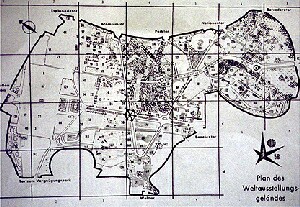|
1 2 |
 Copyright: Das Bayerland, Jg. 60, 1958, H. 6, S. 228 |
The site selected for the exposition was the Plateau von Heysel, a park near the Royal Laekener Castle to the north-west of the city. Covering around 200 hectares the grounds were approximately one third of the size of Brussels` city centre. The layout of the exhibition park was frequently compared with that of a cow. The rump of the cow provided the location for the Belgian section, where a number of exhibition rooms were erected surrounding a reception hall in which the economic, social, technical and scientific achievements of Belgium were showcased. These were complemented by comprehensive exhibitions presenting the development and culture of Belgian-Congo and Rwanda-Burundi - the two Belgian colonies in Africa, where amongst other things replicas of African villages were presented with examples of tropical vegetation. Directly adjacent was the folklore section, "Belgium 1900", which included a replica of a small Belgian town at the turn of the century made of plaster and papier mâché, populated by groups of actors celebrating festivals on a daily basis between buildings housing craftsmen, landlords and entertainers. To set signposts for the aspiration of global co-operation international organisations such as the UN, the Council of Europe, Benelux, OEEC, the European Coal and Steel Union, the Council for Customs Co-operation and the International Red Cross all had their own presentations.
The international section showed many exhibitions of art and science in the halls of the 1935 Brussels World Exposition. Whereas the art exhibition was divided into two areas - "Modern Art" and "Man and Art" - the international Hall of Sciences was to provide visitors with an in-depth picture of the most recent scientific knowledge in four sections - atomic, molecular, crystal, and the living cell. The head and the shoulders of the cow were host to the presentations of various nations. In order to link the Belgian section with the foreign contributions located in the public part of the Royal Park, a 450 metres pedestrian bridge was built at an elevation of fifteen metres to provide visitors with an excellent view across the various pavilions and extensive gardens. A chair lift was also installed and visitors could also choose to ride on a small railway which circulated around the site. A path led not only from each of the ten entrances, which left the grounds in all compass directions, but also the helicopter landing pad in the rear leg and the bus station in the tail of the cow, forming a star pattern of avenues, synonymous with arteries to the heart of the exposition cow: the Atomium - which remains today the lasting symbol of the exposition.
| Year: 1958 | City: Brussels | Country: Belgium |
| Duration: 17th April - 19 October 1958 | ||